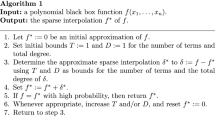Abstract
We provide an explicit construction of elements of the middle third Cantor set with any prescribed irrationality exponent. This answers a question posed by Kurt Mahler.
Similar content being viewed by others
References
Adamczewski, B., Bugeaud, Y.: Mesures de transcendance et aspects quantitatifs de la méthode de Thue–Siegel–Roth–Schmidt. Preprint
Allouche J.-P. and Shallit J.O. (2003). Automatic Sequences: Theory, Applications, Generalizations. Cambridge University Press, Cambridge
Beresnevich V., Dickinson H. and Velani S.L. (2001). Sets of exact logarithmic order in the theory of diophantine approximation. Math. Ann. 321: 253–273
Bugeaud Y. (2003). Sets of exact approximation order by rational numbers. Math. Ann. 327: 171–190
Bugeaud Y. (2004). Approximation by algebraic numbers. Cambridge Tracts in Mathematics 160, Cambridge
Jarní k V. (1931). Über die simultanen diophantische approximationen. Math. Z. 33: 505–543
Kleinbock D., Lindenstrauss E. and Weiss B. (2004). On fractal measures and diophantine approximation. Select. Math. 10: 479–523
Kleinbock D. and Weiss B. (2005). Badly approximable vectors on fractals. Isr. J. Math. 149: 137–170
Kristensen S. (2006). Approximating numbers with missing digits by algebraic numbers. Proc. Edinb. Math. Soc. 49: 657–666
Kristensen S., Thorn R. and Velani S. (2006). Diophantine approximation and badly approximable sets. Adv. Math. 203: 132–169
Levesley J., Salp C. and Velani S.L. (2007). On a problem of K Mahler: diophantine approximation and cantor sets. Math. Ann. 338: 97–118
Mahler K. (1984). Some suggestions for further research. Bull. Austral. Math. Soc. 29: 101–108
van der Poorten A.J. and Shallit J. (1992). Folded continued fractions. J. Number Theory 40: 237–250
Ridout D. (1957). Rational approximations to algebraic numbers. Mathematika 4: 125–131
Schmidt, W.M.: Approximation to algebraic numbers. Monographie de l’Enseignement Mathématique 19, Genève, (1971)
Shallit J. (1979). Simple continued fractions for some irrational numbers. J. Number Theory 11: 209–217
Weiss B. (2001). Almost no points on a Cantor set are very well approximable. R. Soc. Lond. Proc. Ser. A Math. Phys. Eng. Sci. 457: 949–952
Author information
Authors and Affiliations
Corresponding author
Rights and permissions
About this article
Cite this article
Bugeaud, Y. Diophantine approximation and Cantor sets. Math. Ann. 341, 677–684 (2008). https://doi.org/10.1007/s00208-008-0209-4
Received:
Revised:
Published:
Issue Date:
DOI: https://doi.org/10.1007/s00208-008-0209-4



